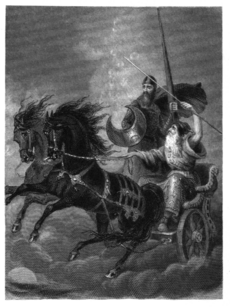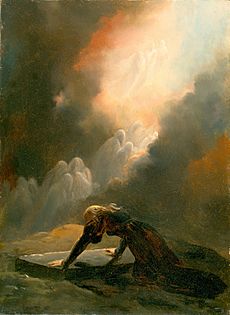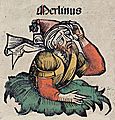Merlin facts for kids
Quick facts for kids Merlin |
|
|---|---|
| Matter of Britain character | |
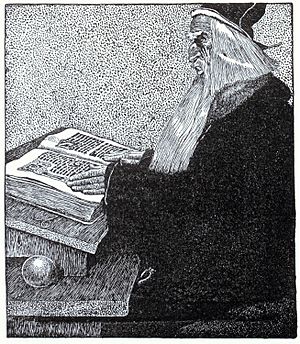
The Enchanter Merlin, Howard Pyle's illustration for The Story of King Arthur and His Knights (1903)
|
|
| First appearance | Prophetiae Merlini |
| Created by | Geoffrey of Monmouth |
| Information | |
| Species | Cambion |
| Occupation | Prophet, magician, bard, advisor, warrior, others (depending on the source) |
| Spouse(s) | Gwendolen |
| Relatives | Ganieda |
| Home | "Esplumoir Merlin", British woods |
Merlin is a legendary character. He is best known as the wizard in the Arthurian legends. He was King Arthur's advisor and mentor. Merlin later disappeared from the tale, leaving behind a series of prophecies foretelling the events yet to come. A popular version from the French prose cycles narrates Merlin being bewitched and forever sealed or killed by his student known as the Lady of the Lake after falling in love with her. Other texts variously describe his retirement or death.
Merlin is always a mysterious figure. He rarely gives his reasons for the things he does. Merlin is usually said to be one with nature, being the source of his enormous power.
Merlin was probably first written about in Welsh legend. His story is based on parts of several different real and fictional characters.
The familiar depiction of Merlin was introduced by the 12th-century British pseudo-historical author Geoffrey of Monmouth and then built on by the French poet Robert de Boron and their prosaic successors in the 13th century.
Contents
Legend
| Selected Merlin episodes | Earliest known sources |
|---|---|
| Birth from a virgin and a demon | Historia Regum Britanniae (c. 1136) |
| Intervention by Blaise redeems Merlin from his intended role of the Antichrist | Prose Merlin (c. 1200) |
| Vortigern seeks a "fatherless child" for a blood sacrifice to strengthen his castle's tower | Historia Brittonum (c. 828) |
| Construction of Stonehenge | Historia Regum Britanniae |
| Uther Pendragon takes on the appearance of the Duke of Cornwall though a spell by Merlin and conceives Arthur with Igraine | Historia Regum Britanniae |
| Merlin chooses the original Knights of the Round Table | Prose Merlin |
| Excalibur pulling contest to prove the young Arthur's divine right to the throne of King of the Britons | Prose Merlin |
| Arthur is warned of Mordred's birth and the coming fall of his kingdom | Post-Vulgate (c. 1235) |
| Merlin sets up the search for the Holy Grail by the Knights of the Round Table | Prose Perceval (after 1200) |
| Blaise writes down the story of Merlin | Prose Merlin |
| Entrapment by the fairy Viviane | Lancelot-Grail (before 1235) |
Geoffrey and his sources
Geoffrey's composite Merlin is based mostly on the North Brythonic poet and seer Myrddin Wyllt, that is Myrddin the Wild (known as Merlinus Caledonensis or Merlin Sylvestris in later texts influenced by Geoffrey). Myrddin's legend has parallels with a northern Welsh and southern Scottish story of the mad prophet Lailoken (Laleocen), probably the same as Myrddin son of Morfryn (Myrddin map Morfryn) mentioned in the Welsh Triads, and with Buile Shuibhne, an Irish tale of the wandering insane king Suibihne mac Colmáin (often Anglicised to Sweeney). In Welsh poetry, Myrddin was a bard driven mad after witnessing the horrors of war, who fled civilization to become a wild man of the wood in the 6th century. He roams the Caledonian Forest, until cured of his madness by Kentigern, also known as Saint Mungo. Geoffrey had Myrddin in mind when he wrote his earliest surviving work, the Prophetiae Merlini ("Prophecies of Merlin", c. 1130), which he claimed were the actual words of the legendary poet (including some distinctively apocalyptic prophecies for the future past the 12th century), however revealing little about Merlin's background.
Geoffrey was also further inspired by Emrys (Old Welsh: Embreis), a character based in part on the 5th-century historical figure of the Romano-British war leader Ambrosius Aurelianus (Welsh name Emrys Wledig, also known as Myrddin Emrys). When Geoffrey included Merlin in his next work, Historia Regum Britanniae (c. 1136), he supplemented his characterisation by attributing to Merlin stories concerning Ambrosius, taken from one of his primary sources, the early 9th-century Historia Brittonum attributed to Nennius. In the latter account, Ambrosius was discovered when the King of the Britons, Vortigern, attempted to erect a tower at Dinas Emrys (City of Emrys). More than once, the tower collapsed before completion. Vortigen's wise men advised him that the only solution was to sprinkle the foundation with the blood of a child born without a father. Ambrosius was rumoured to be such a child. When brought before the king, Ambrosius revealed that below the foundation of the tower was a lake containing two dragons battling into each other, representing the struggle between the invading Saxons (the white dragon) and the native Celtic Britons (the red dragon). Geoffrey retold the story in his Historia Regum Britanniæ, adding new episodes that tie Merlin with King Arthur and his predecessors. Geoffrey stated that this Ambrosius was also called "Merlin", therefore Ambrosius Merlinus.
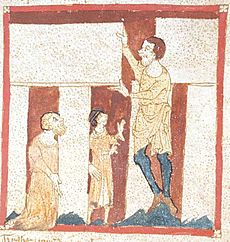
Therefore, Geoffrey's account of Merlin's early life is based on the story from the Historia Brittonum. The name of Merlin's mother is not stated, but is given as Adhan in the oldest version of the Prose Brut, the text also naming his grandfather as King Conaan. Merlin is born all hairy and already able to speak like an adult even as an infant, as well possessing supernatural knowledge that he uses to save his mother. The story of Vortigern's tower is the same; the underground dragons, one white and one red, represent the Saxons and the Britons, and their final battle is a portent of things to come. At this point Geoffrey inserted a long section of Merlin's prophecies, taken from his earlier Prophetiae Merlini.
Geoffrey dealt with Merlin again in his third work, Vita Merlini (1150). He based it on stories of the original 6th-century Myrddin, set long after his time frame for the life of Merlin Ambrosius. Nevertheless, Geoffrey asserts that the characters and events of Vita Merlini are the same as told in the Historia Regum Britanniae. Here, Merlin survives the reign of Arthur, about the fall of whom he is told by Taliesin. Merlin spends a part of his life as a madman in the woods and marries a woman named Guendoloena (a character inspired by the male Gwenddoleu ap Ceidio). He eventually retires to observing stars from his house with seventy windows in the remote woods of Rhydderch. There, he is often visited by Taliesin and by his own sister Ganieda (a Latinized name of Myrddin's sister Gwenddydd), who has become queen of the Cumbrians and is also endowed with prophetic powers.
Nikolai Tolstoy hypothesized that Merlin is based on a historical personage, probably a 6th-century druid living in southern Scotland.
Later developments
Sometime around the turn of the following 13th century, Robert de Boron retold and expanded on this material in Merlin, an Old French epic poem presenting itself as the story of Merlin's life as told by Merlin himself to be written down by the "real" author (the actual author claiming having penned merely a French translation). Only a few lines of what is believed to be the original text have survived, but a more popular prose version had a great influence on the emerging genre of Arthurian-themed chivalric romance.
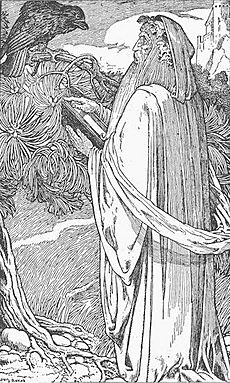
The prose version of Robert's poem was then continued in the 13th-century Merlin Continuation or the Suite de Merlin. It features King Arthur's early wars and Merlin's role in them, as the mage both predicts and, wielding elemental magic, influences the course of battles, also helping the young Arthur in other ways. The extended prose rendering of Merlin became one of the foundations for the Lancelot-Grail, a vast cyclical series of Old French prose works also known as the Vulgate Cycle, when it was directly incorporated into it as the Estoire de Merlin, also known as the Vulgate Merlin or the Prose Merlin. There, while not identifying his mother, it is stated that Merlin was named after his grandfather on her side. A further reworking and continuation of the Prose Merlin was included within the subsequent Post-Vulgate Cycle as the Post-Vulgate Suite du Merlin or the Huth Merlin, adding some episodes such as Merlin providing Arthur with the magic sword Excalibur through a Lady of the Lake. His magical interventions in the Post-Vulgate Merlin are relatively limited and markedly less spectacular (even compared to the magical feats of his own students), and his character becomes less moral; Merlin's prophesies now also include sets of alternate possibilities instead of the certain outcomes. All these variants have been adapted and translated into several other languages as well as further modified.
The earliest English verse romance concerning Merlin is Of Arthour and of Merlin of the late 13th century, which drew from the chronicles and the Vulgate Cycle. In English-language medieval texts that conflate Britain with the Kingdom of England, the Anglo-Saxon enemies against whom Merlin aids first Uther and then Arthur tend to be replaced by the Saracens or simply just invading pagans. In Britain, Merlin has remained as much as prophet as a magician up to and including the 16th century, when political contents in the style of Agrippa d'Aubigné continued to be written using Merlin's name to guarantee their authenticity. Welsh works predicting the Celtic revenge and victory over the Saxons would be recast as Merlin's (Myrddin's) prophecies and used along with Geoffrey by propaganda of the Welsh-descent Henry VII of England (who fought under red dragon banner) as the House of Tudor, which traced its lineage directly to Arthur, and their Welsh supporters including bards, interpreted the prophecy of King Arthur's return as having been fulfilled after their ascent to the throne of England that they sought to legitimise following the Wars of the Roses. Before that, prophecies attributed to Merlin have been also used by the Welsh hero Owain Glyndŵr in his fight against the English rule.
Merlin's end
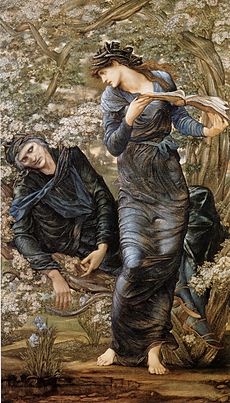
Purported sites of Merlin's burial include a cave deep inside Merlin's Hill (Welsh: Bryn Myrddin), outside Carmarthen. Carmarthen is also associated with Merlin more generally, including through the 13th-century manuscript known as the Black Book and the local lore of Merlin's Oak. In North Welsh tradition, Merlin retires to Bardsey Island (Welsh: Ynys Enlli), where he lives in a house of glass (Welsh: Tŷ Gwydr) with the Thirteen Treasures of the Island of Britain (Welsh: Tri Thlws ar Ddeg Ynys Prydain). One site of his tomb is said to be Marlborough Mound in Wiltshire, known in medieval times as Merlebergia (the Abbot of Cirencester wrote in 1215: "Merlin's tumulus gave you your name, Merlebergia"). Another site associated with Merlin's burial, in his 'Merlin Silvestris' aspect, is the confluence of the Pausalyl Burn and River Tweed in Drumelzier, Scotland. The 15th-century Scotichronicon tells that Merlin himself underwent a triple-death, at the hands of some shepherds of the under-king Meldred.
Modern culture

Merlin and stories involving him have continued to be popular from the Renaissance to the present day, especially since the renewed interest in the legend of Arthur in modern times. As noted by Arthurian scholar Alan Lupack, "numerous novels, poems and plays centre around Merlin. In American literature and popular culture, Merlin is perhaps the most frequently portrayed Arthurian character." According to Stephen Thomas Knight, Merlin embodies a conflict between knowledge and power: a symbol of wisdom in the first Welsh stories, he became an advisor to kings in the Middle Ages, and eventually a mentor and teacher to Arthur and others in the works around the world since the 19th century.
Since the Romantic period, Merlin has been typically depicted as a wise old man with a long white beard, creating a modern wizard archetype reflected in many fantasy characters such as JRR Tolkien's Gandalf or JK Rowling's Dumbledore that also use some of his other traits. Things named in honour of the legendary figure have included asteroid 2598 Merlin, companies Merlin and Merlin Entertainments, handheld console Merlin, literary magazine Merlin, metal band Merlin, and more than a dozen different British warships each called HMS Merlin.
Images for kids
-
Jean Colombe's illumination of the story of Merlin's unholy birth as told in the Prose Merlin (c. 1480)
-
Merlin and Nimue in Romance of King Arthur (1917) abridged from Le Morte d'Arthur by Alfred W. Pollard, illustrated by Arthur Rackham: "How by her subtle working she made Merlin to go under the stone to let wit of the marvels there and she wrought so there for him that he came never out for all the craft he could do."
See also
 In Spanish: Merlín para niños
In Spanish: Merlín para niños




